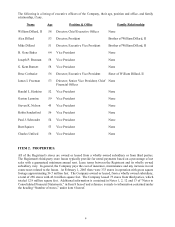Dillard's 2002 Annual Report Download - page 20
Download and view the complete annual report
Please find page 20 of the 2002 Dillard's annual report below. You can navigate through the pages in the report by either clicking on the pages listed below, or by using the keyword search tool below to find specific information within the annual report.
of SFAS No. 123 to require more frequent and prominent disclosures in financial statements of the effects of stock-
based compensation. The transition guidance and annual disclosure provisions of SFAS No. 148 are effective for
fiscal years ending after December 15, 2002. The interim disclosure provisions are effective for financial reports
containing financial statements for interim periods beginning after December 15, 2002. The Company has adopted
the disclosure provisions of SFAS No. 148 as of December 31, 2002 and has not adopted the fair-value based method
of accounting.
Financial Accounting Standards Board (“FASB”) Interpretation No. 45, “Guarantor’s Accounting and Disclosure
Requirements for Guarantees, Including Indirect Guarantees of Indebtedness of Others” (“FIN 45”) was issued in
November 2002. FIN 45 requires the recognition of a liability for certain guarantee obligations issued or modified
after December 31, 2002. FIN 45 also clarifies disclosure requirements to be made by a guarantor for certain
guarantees. The disclosure provisions of FIN 45 are effective for fiscal years ending after December 15, 2002. FIN 45
is not expected to have a material impact on the Company’s results of operations, financial position or cash flows,
and the Company has adopted the disclosure provisions of FIN 45 as of December 31, 2002.
FASB Interpretation No. 46, “Consolidation of Variable Interest Entities, an Interpretation of APB No. 50” (“FIN
46”) was issued in January 2003. FIN 46 requires certain variable interest entities to be consolidated by the primary
beneficiary of the entity if the equity investors in the entity do not have the characteristics of a controlling financial
interest or do not have sufficient equity at risk for the entity to finance its activities without additional subordinated
financial support from other parties. FIN 46 is effective for all new variable interest entities created or acquired after
January 31, 2003. For variable interest entities created or acquired prior to February 1, 2003, the provisions of FIN 46
must be applied for the first interim or annual period beginning after June 15, 2003. The adoption of FIN 46 is not
expected to have an impact on the Company’s results of operations, financial position or cash flows.
Forward-Looking Information
Statements in the Management’s Discussion and Analysis of Financial Condition and Results of Operations include
certain “forward-looking statements,” including (without limitation) statements with respect to anticipated future
operating and financial performance, growth and acquisition opportunities, financing requirements and other similar
forecasts and statements of expectation. Words such as “expects,” “anticipates,” “plans” and “believes,” and
variations of these words and similar expressions, are intended to identify these forward-looking statements. The
Company cautions that forward-looking statements, as such term is defined in the Private Securities Litigation
Reform Act of 1995, contained in this report, the Company’s annual report on Form 10-K, or made by management
are based on estimates, projections, beliefs and assumptions of management at the time of such statements and are not
guarantees of future performance. The Company disclaims any obligation to update or revise any forward-looking
statements based on the occurrence of future events, the receipt of new information, or otherwise. Forward-looking
statements of the Company involve risks and uncertainties and are subject to change based on various important
factors. Actual future performance, outcomes and results may differ materially from those expressed in forward-
looking statements made by the Company and its management as a result of a number of risks, uncertainties and
assumptions. Representative examples of those factors (without limitation) include general retail industry conditions
and macro-economic conditions; economic and weather conditions for regions in which the Company’s stores are
located and the effect of these factors on the buying patterns of the Company’s customers; the impact of competitive
pressures in the department store industry and other retail channels including specialty, off-price, discount, internet,
and mail-order retailers; trends in personal bankruptcies and charge-off trends in the credit card receivables portfolio;
changes in consumer spending patterns and debt levels; adequate and stable availability of materials and production
facilities from which the Company sources its merchandise; changes in operating expenses, including employee
wages, commission structures and related benefits; possible future acquisitions of store properties from other
department store operators and the continued availability of financing in amounts and at the terms necessary to
support the Company’s future business; potential disruption from terrorist activity and the effect on ongoing
consumer confidence; potential disruption of international trade and supply chain efficiencies; world conflict,
including the war with Iraq and the possible impact on consumer spending patterns and other economic and
demographic changes of similar or dissimilar nature.
14
























